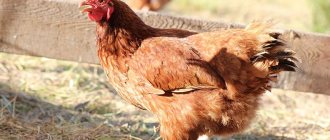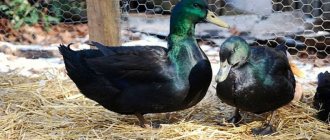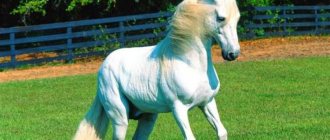The Adler silver breed of chickens for meat and eggs was bred for the southern regions. The bird has a calm character, strong immunity to most diseases, and does not require care. What rules should be followed so that hens are pleased with high egg production rates, and roosters gain weight well - read further in the article.
Description of birds
Adler silvers are very popular among farmers. They are unpretentious, quickly adapt to any living conditions, have a good-natured and calm disposition and an attractive appearance.
Appearance
The Adler bird has only one color - white with black feathers on the neck, tail and wings (Colombian). Chickens have yellow down. The scallop is leaf-shaped, red. The beak and legs are yellow. The presence of feathers on the legs is unacceptable.
INTERESTING! Adler roosters have the same coloring as hens, this distinguishes them from many breeds.
Character of chickens
Adler Silvers are balanced, not shy, and get along well with other animals and birds. They quickly get used to their owners. The roosters are not aggressive, caring, and will never approach the feeder until the hens have eaten.
What do chickens get sick with?
Chickens of the Adler breed often suffer from leg diseases (especially joint diseases), so it is unacceptable to keep them in damp conditions; there should always be bedding on the floor of the poultry house. In humid climates, perches are necessary.
Otherwise, the bird has good health and high immunity. But, under unfavorable living conditions and poor feeding, infectious and non-infectious diseases can develop.
Characteristics of Adler silver chickens
Adler silvers belong to the meat-egg variety. Cockerels can be raised and get good meat carcasses. Laying hens produce large edible eggs throughout the year.
Meat productivity
By the first year of life, Adler roosters reach a weight of 3.5 to 4 kg, but they are released for meat at 5-6 months. The average carcass weight is 1.5-2.5 kg, depending on the age of the bird. It is quite muscular, not fatty, and has excellent taste.
Egg production
The average productivity indicators of Adler silvers are as follows:
- per year, one hen produces from 170 to 200 eggs;
- shell color is light beige or cream;
- The weight of the testicle varies from 55 to 65 grams.
The highest productivity is observed in the first two years of life, then it gradually decreases.
REFERENCE! Adler chickens can be kept on the farm for 4-5 years, then the flock needs to be renewed.
When is the egg production period for chickens?
With proper feeding and maintenance, chickens begin to lay their first eggs at 6-6.5 months. It is not recommended to provoke Adler laying hens to lay eggs early, as this can lead to prolapse of the oviduct and other health problems.
Molting period and egg laying break
The first moult occurs in a young bird at the age of 16-20 weeks. This usually happens in the spring. Adult laying hens molt once a year in the autumn. On average, molting lasts about 2 months, this period depends on the conditions of detention, lighting and diet.
Usually, during molting, the bird stops laying eggs, but farmers note that Adler silvers continue to produce eggs, although their number is sharply reduced. It is very important not to overfeed a molting bird, otherwise it may become fat.
Diet
Since this is a “Soviet” bird, it is quite unpretentious in terms of nutrition. However, the chicken must be provided with the proper amount of protein and calcium.
Protein and calcium play a vital role in egg production. If a chicken lacks protein and calcium, it will begin to lay very small eggs (approximately 40 g each), which is a huge disadvantage even when raising poultry at home.
We recommend reading: Description of the Foxy Chick chicken breed
In addition, in the case of chickens, without protein they will be very much behind in development.
Breeding
Adler chickens, unlike crosses, exactly pass on all productive characteristics to their offspring. Before breeding this bird, it is necessary to correctly form a parent flock.
Only the best representatives of the breed are selected for breeding work. Chickens and roosters should not have any defects (rose-shaped comb, feathers on their legs, etc.). The optimal ratio of hens to roosters is 10 to 1.
Hatching instinct
Hens belonging to the Adler Silver breed almost never sit down to hatch eggs. An incubator is used to produce chicks.
In order for the offspring to be purebred, it is necessary to remove roosters of other breeds from hens 20 days before collecting eggs.
Incubation of offspring
Adler silver eggs are incubated for 21 days. It is very important to maintain temperature and humidity conditions throughout the hatching period.
| Incubation days | Temperature | Humidity in % | Ventilation | Turn |
| 1-11 | 37,9 | 66 | — | 4 times a day |
| 12-17 | 37,3 | 53 | 2 times a day for 5 minutes | |
| 18-19 | 37,3 | 47 | 2 times a day for 20 minutes | |
| 20-21 | 37 | 66 | 2 times a day for 5 minutes | — |
Eggs are not washed before incubation. The shells are disinfected with Monclavit by irrigation. You can also use hydrogen peroxide or a weak solution of manganese.
Egg selection rules
Eggs for incubation are selected according to the following criteria:
- weight from 58 to 65 grams;
- correct form;
- strong shell without cracks, growths or chips;
- absence of heavy contamination on the shell;
- presence of only one yolk.
Only those eggs that have been stored for no more than a week at a temperature of 7-10 degrees are suitable for incubation. They are placed in a container with the blunt end up.
Caring for newborn chicks
After hatching or acquisition, chickens are placed in a warm brooder (box). In the first week, absorbent diapers, paper, large shavings or hay are used as bedding. It is not recommended to fill the floor with fine sawdust, as chickens may peck at it.
It is very important to observe light and temperature conditions.
| Age in days | Temperature (degrees) | Daylight hours (hours) | |
| In a brooder (cage) | In room | ||
| 1-5 | 33-34 | 24-26 | 24 |
| 6-12 | 30-32 | 22-23 | 16-18 |
| 13-20 | 25-29 | 21-22 | 9-12 |
| 21-30 | 22-25 | 20-21 | 9-10 |
REFERENCE! The stocking rate in the first 2 weeks of chicken life is 70-80 birds per square meter. By 4-5 weeks they are seated at 35-37 heads per m2.
Diet for chickens up to 1 month
The best option for feeding small chickens from birth is ready-made industrial feed. They are poured into hopper or tray feeders. In the first month of life, chickens eat feed without restrictions.
Suitable for Adler silvers:
- PK-2 (Bogdanovichsky feed mill);
- sun for chicks from 0 to 4 weeks;
- Purina Egg Starter;
- a kind villager for the chickens.
If there are only a few chickens, you can prepare a mash for them. To do this, finely chop a boiled egg and mix it with corn grits and crushed wheat. From 5-6 days you can add a little boiled potatoes to the mash.
Every day, the chickens have green onions finely chopped. From the third day homemade crumbled cottage cheese is added to the diet. Vitamins (Chiktonik, Tetravit, ascorbic acid, etc.) are added to the water according to the instructions.
Ready-made dry feed can be left in the brooder around the clock. Mixtures are given to chickens several times a day for no more than 15-20 minutes. Then the bowls with wet food should be put in a cool place. It is necessary to ensure that there is always clean water in the drinking bowls.
Feeding chickens older than a month
From the first month (from 4 weeks), Adler silver chickens are fed both mixed feed and homemade mash. From ready-made feeds, it is recommended to give PK-4 (Bogdanovichsky plant) or Solnyshko PRO Economy for young animals from 5 to 16 weeks.
You can prepare a grain mixture for chickens yourself:
- wheat – 3.8-4 kg;
- corn – 3 kg;
- sunflower cake or meal – 1.8-2 kg;
- feed yeast – 0.3 kg;
- fish meal – 0.6 kg;
- herbal flour – 0.3 kg;
- shell – 0.1-0.2 kg;
- premix for chickens – 0.1 kg.
All ingredients are mixed in the required proportions and sent to the crusher. If chickens are raised in the summer, they must be given fresh greens in addition to the grain mixture or feed.
REFERENCE! At the age of 1-2 months, one Adler silver chicken eats about 45-70 grams of feed or grain mixture per day.
Content Features
Adler silvers are not picky about the conditions they are kept in; they can be bred in open-air cages, spacious cages, they feel very good on walks, where they successfully find food by foraging.
Summer content
In the summer, in free-range conditions, chickens will lay eggs better and gain weight. At night they can be kept:
- in a poultry house, closed on all sides by walls;
- in an enclosure, where 1 or 2 walls are replaced with a net.
When arranging a poultry house or aviary, adhere to the following standards:
- Place for a chicken coop . If possible, choose an area on a hill so that it is always dry.
- Square. Calculate using the formula: 1 sq. m of area for 2 individuals or the total number of chickens, divide by 3.
- Litter. Cover the floor with dry bedding.
- Feeders and drinkers. Set it up so that all the chickens can approach it together. Otherwise, stronger and more authoritative individuals will drive away smaller and weaker ones. Read how to make your own chicken feeder here.
- Perches. Install at a height of 0.6-1 m from the floor in a remote, darkened and warm part of the building. There should be at least 30 cm of pole per individual. Its thickness should be such that the bird can grasp it well with its paws. Material – wood.
With a large number of livestock, birds can be kept on the floor without equipping perches.
- Nests. The optimal nest size is 30x40x45 cm. Place them in the driest places farthest from the exit. Place straw or sawdust inside. It’s good if the sides protrude 5-10 cm above the flooring.
- Baths. Place ash or sand baths in bird habitats to clean feathers.
- Cleaning. In the summer, clean and replace the litter once every 14 days.
Arrangement of a walking yard:
- Fencing . Take care to fence the walking area. The height of the fence should be 2 m or more. Make it from metal or nylon mesh with cells up to 5 cm.
- Low humidity. Choose an area where water will not stagnate after rains.
- Coating. For Adler chickens, sown grass or meadow flowers underfoot are well suited.
- Feeders, drinking bowls, baths. In summer you can take it out into the walking yard. Take care to build a rain shelter so that water does not flood the food and dry bath tubs.
From this article you will learn how to make a drinking bowl yourself.
- Laz. Connect the poultry house with the walking area using a manhole so that the chickens can move around it freely.
Features of care
A special feature of care is that Adlers need high, dry and soft bedding that absorbs moisture well.
Suitable bedding:
- sawdust;
- moss peat;
- coconut fiber;
- straw;
- fine gravel;
- A small amount of lime can be added to the litter.
Regardless of the conditions of detention, care should be taken to ensure soft, loose and dry bedding on the floor.
Feeding
For the full development of Adler chickens, the body needs nutrients. The daily diet looks like this:
- Corn. Chickens are good at ingesting both crushed and whole grains, even corn. This does not affect digestion and absorption.
- Vegetables. Can make up up to 50% of the total diet. Give fresh zucchini, cucumbers, pumpkin with seeds, and fodder beets. You can also pre-grind them and add them to the mash.
- Greenery. The bird needs it every day. Chickens happily eat dandelion, nettle, woodlice, clover, and tops. Feed them freshly picked grass or add chopped grass to your mash.
Greens, as a staple food, are given to birds that are too fat.
- Compound feed. Buy for meat and egg breeds. Give it in the morning, sometimes mix it steamed into the mash.
- Protein supplements . To increase the size of the egg, you need to add protein to your food. Give it to your birds at the rate of 10 g per bird per day. Porridge with meat or fish broth, bone or meat-and-bone meal, and dairy products work well in this capacity.
- Vitamins and minerals. It’s better to buy ready-made complexes and mix them into food. Important elements are phosphorus and calcium, vitamins A, B, E, D.
- Water. Must always be fresh. Top it up 2 times a day and wash the drinkers every day.
Feed
Chickens are fed 3 times a day. In the morning and evening they give feed and grain, in the afternoon - mash.
The diet depends on the age of the hen.
Table of approximate list of feeds for 1 chicken per day:
| Feed for 1 chicken | Age 22-47 weeks | Age over 47 weeks |
| Boiled potatoes, g/day | 50 | 50 |
| Corn, g/day | 40 | — |
| Greens, g/day | 30 | 30 |
| Wheat, g/day | 20 | 40 |
| Meal, g/day | 11 | 14 |
| Carrots, g/day | 10 | — |
| Meat and fish waste, g/day | 5 | 10 |
| Rakushnyak, g/day | 5 | 5 |
| Fishmeal, g/day | 4 | — |
| Chalk, g/day | 3 | 3 |
| Yeast, g/day | 1 | 14 |
| Bone meal, g/day | 1 | 1 |
| Barley, g/day | — | 30 |
| Pumpkin, g/day | — | 20 |
If you regularly eat fish, the meat of slaughtered poultry will have a fishy smell.
Egg production can be increased depending on the increase or decrease in the consumption of certain foods.
Chicken feeding table to increase egg production:
| Feed for 1 chicken | Egg production 50% | Egg production 60% | Egg production 70% |
| Wheat, g/day | 25 | 30 | 35 |
| Oats, g/day | 15 | 15 | 15 |
| Millet, g/day | 10 | 10 | 10 |
| Sunflower cake, g/day | 20 | 20 | 20 |
| Wheat bran, g/day | 40 | 20 | 20 |
| Flour, g/day | 5 | 5 | 5 |
| Bone meal, chalk, g/day | 5 | 10 | 10 |
Maintenance in winter
When preparing for winter, carry out the following work:
- Insulation . Seal all cracks and holes to prevent drafts in the chicken coop. Take care to insulate the door; it should close tightly, without gaps. Place a thick layer of bedding on the floor. When it has softened, loosen the top layer with a rake or replace it with a new one if it gets dirty enough.
- Walking. Chickens need to go outside every day. An aviary is best suited for this. Insulate the floor with a layer of bedding. Install protection from wind and precipitation.
- Lighting. Install fluorescent lamps in the coop to extend the illumination to 13-15 hours a day.
- Feed. In winter, make sure that wet food does not have time to cool down while it is being eaten, and especially not left to freeze in the feeder. Increase your intake of vegetables and greens in the form of hay.
- Water. Make sure that the water does not freeze in the drinking bowls.
- Hygiene. Clean the poultry house every week.
Bird health
Adler chickens very rarely get sick, as they have strong immunity. However, contact with wild birds, poor living conditions or an incorrectly formulated diet can trigger the development of certain diseases (pasteurellosis, Marek's disease, helminthiasis, etc.).
Common Breed Diseases
Most often on farms you can encounter the following infectious diseases of Adler silverbacks:
- Marek's disease. The virus affects the nervous system, causing the bird to go blind and suffer from paralysis. The head is thrown back, lameness appears. About 30-50% of infected chickens die. Sick birds are slaughtered and burned.
- Newcastle disease. This virus affects the nervous and respiratory systems. The bird does not eat, often falls, mucus flows from its beak, and its comb turns blue. There is no cure. Sick chickens are destroyed and burned.
- Laryngotracheitis. This disease is more common in autumn and winter. It develops against the background of drafts and lower temperatures. Sick chickens fluff themselves up, sit with their eyes closed, and wheeze. Mucus flows from the beak and eyes, and egg production decreases. The disease is treated with Tromexin.
- Pasteurellosis. The main carriers are sick birds and rodents. The mortality rate ranges from 80 to 100%. The chickens' temperature rises and their combs turn blue. Foamy discharge is visible from the beak. The bird refuses to eat, but at the same time drinks greedily. The disease is treated with Sulfanilamide.
- Pullorosis. Both young and adult laying hens get sick. The bird has foamy diarrhea and the scallop “withers.” Sick chickens lose weight, eat poorly, and breathe heavily. The disease is treated with antibiotics (Neomycin or Biomycin).
In farms where parasite treatment is not carried out, Adler silvers may suffer from helminthiasis. Adult poultry or chickens grow poorly, appetite disappears, and egg production decreases.
Another common problem is beetle infestation. Chickens are constantly itching and plucking feathers. Bald patches appear on the body. You can see the feather eater by spreading the feathers under the wings.
ATTENTION! Any treatment should only be prescribed by a veterinarian. If your bird is sick, you should call a specialist. The veterinarian will conduct a diagnosis and write out a detailed treatment plan.
Support and enhance immunity
The immunity of Adler breed chickens and cockerels can be increased with natural supplements or ready-made products from a veterinary pharmacy.
Natural remedies to stimulate the immune system:
- Garlic. Add one crushed clove of garlic to a liter of water. This mixture is offered to chickens 1-2 times a week. Garlic has an antimicrobial effect.
- Herbs and spices. You can add oregano oil or natural crushed cinnamon to the food. These spices have antioxidant and antibacterial properties.
- Greenery. Dandelions, fresh cabbage, plantain, and clover are very useful for Adler silverbacks. In winter, you can sprout grain for chickens (barley, wheat or oats).
- Apple vinegar. It improves digestion and increases the absorption of calcium from feed. A tablespoon is diluted in 4 liters of water and this mixture is offered to the chickens.
Among veterinary drugs, the following drugs will help strengthen the immune system: Katozal (Cyanofor), Fosprenil, ASD 2, Gamavit, Hepatonic. These products are added to drinking water strictly according to the instructions.
Such drugs are used in the autumn and winter months to increase the body’s overall resistance to various viral diseases.
Prevention of chicken diseases
Prevention consists of regular disinfection of the premises and all equipment. When purchasing new chickens, they must be quarantined in a separate room for 2-3 weeks, only after this time they are released into the general herd.
It is necessary to monitor the quality of the feed: there should be no mold in it. Adler silverbacks should be protected from contact with wild rodents and birds, as they are carriers of dangerous diseases.
Also an effective preventive measure is timely vaccination of the entire livestock against all viral diseases that occur in a particular region. Information about this can be obtained from your local veterinary station.
Diseases
The main infectious diseases dangerous to livestock:
- Marek's disease;
- infectious bronchitis;
- coccinosis;
- salmonellosis (avian paratyphoid fever);
- mycoplasmosis;
- Gaboro disease;
- bird flu;
The most effective prevention of the problem is compliance with the conditions of care and timely vaccination of birds. There are also invasive diseases:
- feather mite;
- lice eaters of various types;
- fleas;
- various helminths.
Prevention of the problem - compliance with the rules of care, regular inspection of birds.
Interesting Facts
Adler silvers are used to produce autosex offspring (chickens can be distinguished by color at one day of age). Such chicks are obtained from a combination of pedigree hens and Rhode Island or New Hampshire roosters.
INTERESTING! The young animals obtained from this combination gain weight very quickly. It can be raised for meat along with broilers.
Adler silver ones are a good option for a personal yard. These chickens rarely get sick, have a calm character, and produce eggs for 3-4 years. However, if you want to get offspring from your bird, you will have to purchase an incubator and hatch the chickens yourself.
Character
Representatives of this breed have a fairly peaceful and calm character. Most often, they get along well in a new place, next to other breeds of chickens.
Adlers can get along well not only with their own kind, but also with other birds, such as quails or pigeons.
For humans, a rooster of this breed does not pose any danger, although it has quite impressive dimensions.
But even despite its peace-loving nature, this is not a cowardly breed. If you provoke a rooster, he will certainly respond, and respond very seriously.
As for noise, this is a fairly quiet breed. Laying hens rarely cackle just like that, doing this exclusively at the moment when they laid an egg. As for roosters, their voice is very pleasant and loud.
Reasons for rejection
There are only a few reasons for rejection:
- the presence of long braids in the rooster's tail;
- thin and long neck;
- the comb is not standing or has an inclined position.
In industrial production, defective chickens are slaughtered immediately after signs of being out of breed are revealed. In private farms, cockerels are raised for up to one year and then slaughtered for meat, and chickens are kept if their productivity indicators meet the norm. But eggs from such a chicken are not used for breeding.
Advantages and disadvantages of the breed
Birds belonging to the Adler breed are highly valued by farmers for several reasons:
- beautiful appearance;
- flexible, peaceful character;
- good egg yield;
- rapid weight gain;
- wonderful taste of meat;
- unpretentiousness;
- stress resistance;
- undemanding to the food supply;
- viability of young animals;
- egg fertilization rate – 90%.
This breed also has some disadvantages. For example, the absence of maternal instinct and a high rate of loss of adult livestock - 14%.
Disease Prevention
Chickens of this breed are not susceptible to any specific diseases, but they can catch a very common illness. Especially if they are kept in the yard with other birds. But in general, their survival rates are very good due to their high immunity - 88-90% on average. However, such a solid indicator is also the merit of the poultry farmer, who must make efforts to preserve the livestock.
The owner needs to disinfect the chicken coop, destroying parasites and rodents. It is necessary to follow the rules of hygiene and not to carry viruses dangerous to birds: work clothes should be washed in a timely manner. Drinkers and feeders must be cleaned regularly. In the room for keeping chickens, it is necessary to maintain dry air and prevent a critical increase in humidity levels. The Adler breed does not tolerate such conditions well; its representatives begin to experience breathing difficulties. You can also vaccinate against major diseases, and during molting, additionally include ready-made vitamin complexes in the birds’ diet.
The chicken coop must be dry - Adlers do not tolerate high humidity
Photo
In the first photo you see an ordinary mature male:
Here a couple more individuals of our breed appear before our eyes:
The following photo shows an Adler silver hen sitting on a stick:
But in these two photographs there are several individuals calmly walking in the courtyard of the house:
Origin
The creation of the breed was carried out by domestic scientists and specialists from the Adler poultry farm in the middle of the last century. The selection process lasted more than one year and was carried out in stages by crossing several breed lines: “Russian White”, “Pervomaiskaya”, “New Hampshire”, “Plymouth Rock White”, “Yurlovskaya Volosistaya”. Obtained in 1965, the “Adler Silver” successfully passed state tests and was officially registered in the State Register of the Russian Federation (in 1993) as recommended for keeping and breeding throughout the country.
“Adlers” held a leading position for several decades and formed the basis of the chicken population in most state and collective farms of the former USSR. Now representatives of the breed are raised mainly in private backyards, since in industrial poultry farming it has practically been replaced by modern, more productive broilers and egg crosses.
Raising chickens
Adler silver chickens are distinguished by their strength and friendly hatching. They need a high temperature: 29–31 degrees , and therefore heating must be provided in the cage where they are moved from the incubator. For this you can use either a special red lamp or a regular blue one. Incandescent lamps are not recommended as their bright colors are stimulating and can cause the chick to become very nervous. How best to position the lamp is worth looking at the photo.
In cases where a heater is used, it is important to operate it according to the instructions.
Proper cultivation largely depends on nutrition. The chicks should be fed as soon as they are dry. The first food for babies is a hard-boiled and finely chopped egg. From the second day, chopped green onions, cottage cheese and millet are added to the egg. Dry crushed wheat groats should be available to young animals at all times.
Water is available in the drinking bowl around the clock. If desired, you can add a decoction of nettle or calendula to it to provide the bird with a maximum of vitamins.











